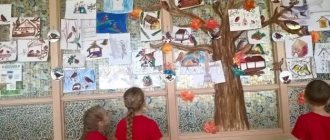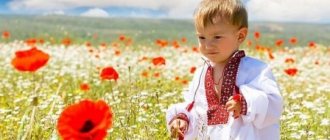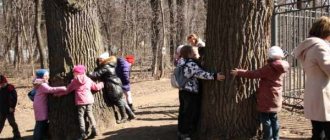Excursion with schoolchildren to the local history museum
Explanatory note:
An excursion to any museum is always very informative and interesting.
Museums are connected with the historical past, present and future of our country. The local history museum of our city contains interesting exhibits of animals from our region, there are separate rooms on the topics of our region: fish, animals, insects, there is a separate room that contains an exhibition of children's works on the topic: “We are children of one planet.” The children listened with great interest the guide told a story and looked at the exhibits. School students live in our region and should know its history, flora and fauna of the region, and the mineral resources of the region. They really enjoyed the excursion. Goal: to form students’ ideas about the local history museum. Objectives: to introduce students to the local history museum of our city; cultivate love for one’s native land; make students want to visit the museum again. ———————————————————- The Khabarovsk Museum of Local Lore was founded in 1894 by the Amur Governor-General N. I. Grodekov. On his initiative, the Amur branch of the Russian Geographical Society was created, of which he was the first chairman. In 1902, the museum was named after its founder. By 1975, a second building with a hall for the “Battle of Volochaevskaya” panorama, one of three panoramas in Russia, was built. In 1994 (the hundredth anniversary of its founding), the name of Grodekov was returned to the museum. In 1998, an archeology museum was opened. In 2000, the Khabarovsk Regional Museum named after N.I. Grodekov won the “Window to Russia” competition and was declared “Museum of the Year” among provincial museums of the Russian Federation. In 2008, the third building was built, which housed a storage facility, a children's museum, an exhibition hall, an exhibition of Amur fish and a fin whale skeleton.[1] From 1977 to 2007, a geological museum operated in Khabarovsk; its entire collection (2,388 samples) was transferred to the regional museum. After reconstruction, the building was transferred to the administration of the Khabarovsk Territory.
The area around the museum.
On April 19, 1894, on the initiative of the Governor-General of the Amur Region N.I.
Grodekov, the State Museum of the Far East was created. By the beginning of the 20th century, it had become the leading museum of the Amur region in Khabarovsk. His exhibits were exhibited at Russian and international exhibitions in Novgorod and Kazan, Chicago and Paris. For ten years, the museum was headed by V.K. Arsenyev, an outstanding traveler, scientist and writer. Over these ten years, the museum has become a leading local history center in the Far East. During the difficult times of the socialist revolution and the years of perestroika, the museum largely lost its scientific potential, but fully retained its function as a cultural and educational center of the Khabarovsk Territory. In 1965, it was even included in the list of the best museums of the RSFSR. The main exhibitions of the museum are thematic halls covering the distant past of the Amur region, its nature, as well as the material and spiritual culture of the Khabarovsk region, the stages of development of the Amur region in the 19th-20th centuries, military conflicts and the period of civil war in the Far East. What did the students see in the local history museum? The students entered the museum and immediately saw a huge exhibit of an old dinosaur.
Then we looked at other exhibits:
Insects of the edge Huge mammoth
Remains of an old dinosaur
Ussuri famous tiger
Far Eastern bear Fossilized shell Fishes of our region Minerals
Birds
A separate room is dedicated to an exhibition of children's works from the art school on the theme: “We are children of one planet.” The excursion aroused great interest among the children.
TO THE MUSEUM AND THE PERSON
Artistic is a way of life, National is part of the country, Museum is the guardian of the image of the Fatherland... We all need your treasures!
Born twice: restlessly young, Open, sinful - like a person Trusting, sublime and smart - You do not accept vanity and running. With a reciprocal glance, contemplating souls, You elevate life and beauty - You serve on the same level with the Hermitage, You cherish the same dream with the Louvre. You are a Belarusian, different cultures are mixed in your blood, the movement of eras - Earthly wisdom and living pranks, Birth cry, and maternal sigh. You are silent in thoughts and desires, Inside you there is harmony of principles, You accept the eternal flow of Water and air, sand and rocks... In your paintings there is meaning and understanding That in the nature of flowers there is both life and death, And the whirlwind of meetings and partings , And a passionate desire to fly. The Museum and the Man live in each other, Flesh and spirit merge in their souls, They are creators and spectators... in the science of loving and talking about it out loud. A. Demyankov.
We recommend watching:
Lesson notes on local history with presentation, 6th grade. G. V. Sviridov Conference on local history for schoolchildren Intellectual quiz with answers for grades 8-9 on local history Tourism and local history program for schoolchildren 12-17 years old
Similar articles:
Local history work at school
Extracurricular lesson on the surrounding world for elementary school. In the museum
Extracurricular lesson on the surrounding world “In the Museum” for elementary school.
Abstract Author Lyapina Vera Valerievna primary school teacher MBOU Secondary School No. 47 Samara City District Description This material is intended for primary and secondary school students. Primary school teachers and class teachers can use the material for extracurricular activities. Goal: Formation of an idea of the museum as a custodian of cultural values. Objectives : Show the role of museums in our lives. Using specific examples, reveal the need for cultural continuity through visiting museums. To consolidate practical knowledge about the rules of conduct in a museum. Develop students' ability to manage their cognitive activity. To cultivate a moral culture, goodwill, and attention to people. Deepen the study of the curriculum.
Progress of the lesson
Organizational moment
Teacher Good afternoon! Today I invite you to visit one wonderful place. We have already been to some of these places. Try to guess what kind of place this is: you need to maintain silence there, not touch objects with your hands, and listen carefully. Ready? Then let's go. Self-determination for activity Teacher A hundred and two hundred years will pass, And three hundred years will pass, But every photograph and portrait, Any thing, any object, will be preserved by the people here. (S. Mikhalkov) So where are we going today? Did you guess it? (To the museum) Well done! What museums have we already visited? (children's answers) Work on the topic of the lesson The curators of the museum come out 1. Guardian Hello, guys! How can you explain in your own words what a museum is? (children's answers) Let's summarize your definitions of what it is: In museums, a tangible memory is stored, Which you can quietly touch, Lightly touch bygone eras, Meager crumbs of former greatness. At night excursions he spends time here, knocking very quietly, timid before the past. Keeping the silence and its exhibits, the ghosts are silent, wiggling viciously. A museum is a unique opportunity to preserve and share with posterity what is most important and important. This is an institution engaged in collecting, studying, storing and exhibiting objects - monuments of natural history, material and spiritual culture. 2 Guardian What do you guys think, how long ago were the first museums created? (children's answers) The word museum comes from the Greek word mouseion, which means “temple of the muse.” The first Museyon was founded in Alexandria in 290 BC. These were living rooms, reading rooms, botanical and zoological gardens, an observatory, and a library.
Later, astronomical instruments, stuffed animals, statues and busts were added to it, which were used in teaching. 3 Guardian In the early period of the Renaissance, Lorenzo de' Medici in Florence, Italy, gave instructions for the creation of a Sculpture Garden.
In France, the most famous museum is the Louvre Palace. The museum was opened in 1793. It consists of 7 departments.
1 Guardian The first museum of a new type was the British Museum in London (opened in 1753). To visit it, you first had to register in writing)
Prosperity to museums! Let the congregations multiply. Keep, study, enlighten us sinners. Everything is in the museums of the world: Products from Tire, Sculpture, furniture, stamps, Gifts from the bowels and seas, Masterpieces and freaks, History of nations, Paintings and coins, Armor and clarinets... It’s impossible to comprehend everything at once, The poor mind is stalled, But we will come to the museums , Let's take a look at this. 2 Guardian Museum art in Russia has gone through the same stages of development as in Europe, and also began with private collecting and collecting. In 1494, on the initiative of Ivan III, the building of the Armory Chamber was erected in Moscow. At first, the Armory Chamber stored and repaired ceremonial princely armor, edged weapons and firearms. Even then, wonderful craftsmen worked here: gunsmiths, chasers, engravers, enamel and filigree makers, who were invited not only from Moscow and its environs, but also from Novgorod, Pskov, Vladimir, and foreigners were also invited. 3 Guardian The appearance of museums (in the modern sense of the word) is associated with the era of Peter I. The people always took care of relics, Guarded treasures from the eyes of strangers In churches, cathedrals and monasteries, And he himself knew about them only in words. But Peter the Great strictly commanded that the Russian people see the treasures, and a museum was opened in St. Petersburg for all ordinary people to see. That century has been replaced by more than one century, but everything that was created by man is now kept in museums throughout the country by connoisseurs of ancient antiquity. They are concentrated and strict, In laboratories, archives, like gods, And with the public they are friendly, smart, Revealing to us the secrets of antiquity.
Peter I begins to assemble his collection. Peter visited the office of the famous anatomist Frederik Ruysch, whose collection of preparations on anatomy and embryology delighted the Tsar. Negotiations for the purchase began. They were completed only in 1716 (Peter paid a huge sum of 30 thousand guilders for the collection at that time); delivery of the collection to Russia took more than a year. This collection then became the basis of the Kunstkamera - the first Russian museum. The first Russian museum had a number of features that distinguished it from many of its European counterparts. It was truly public: “anyone who wanted” was allowed in. Admission was free, moreover, at first visitors were also fed, for which 400 rubles were allocated from the treasury. in year.
1 Guardian Following the example of famous European collections, palace collections of paintings, graphics, and applied arts are being created. Collections were considered as important elements of the educational system: it was believed that engaging in art or even simply contemplating its highest examples develops the intellect, will, and forms good morals. The largest collection that appeared in the 2nd half of the 18th century. - Hermitage Museum. Its idea belonged to Catherine II, who wanted to create a collection of the best examples of Western European painting.
Hermitage Museum. 2 Guardian The founding date of the Tretyakov Gallery is generally considered to be 1856, when the young Tretyakov acquired the first works by contemporary Russian artists, setting out to create a collection that in the future could develop into a museum of national art. A world of magical beauty Museums open to us. Today you visited the Tretyakov Gallery. You are very big now. You understand thoughts and feelings. I wish with all my heart. So that you love art.
“For me, who truly and ardently loves painting, there can be no better desire than to lay the foundation for a public, accessible repository of fine arts that will bring benefit to many and pleasure to all,” the collector wrote in 1860, adding: “... I wanted would like to leave a national gallery, that is, consisting of paintings by Russian artists.”
Physical exercise We repeat all the warm-up movements without hesitation! Hey! They jumped on the spot. Eh! We wave our hands together. Ehe - heh! They bent their backs and looked at the shoes. Hey - hey! Bent down lower. Bent closer to the floor. Turn around in place deftly. We need skill in this. Teacher Guys, what museums do we have in Samara? (children's answers) Now we will get acquainted with the most popular museums in Samara. The museum has velvet comfort and striped marble. In the museum they give you slippers, and the chairs are exhibits! You can’t sit on them anymore And the slippers slide past. The story will begin with the Samara Regional Museum of History and Local Lore. This is the largest city museum, founded by Peter Alabin. This is also the oldest local history museum in the entire Volga region, by the way. It was founded in 1886.
Kurlina's mansion, the family nest of local merchant Alexander Kurlin, who built it for his young wife. This Art Nouveau mansion was so unusual for Samara that writer Alexei Tolstoy mentioned it in his novel “Walking Through Torment,” calling it “ridiculously luxurious.”
At the beginning of the last century in Samara, in the house of the landlord and stepfather A. Bostrom, the family of the writer Alexei Tolstoy lived. Today this estate houses the Alexei Nikolaevich Tolstoy Museum. Here are the writer's personal belongings and things that belonged to members of his family.
This is a local history museum
Industrialist Klodt Museum
And now the modern museums of Samara - Launch Vehicle named after D.I. Kozlov
Police Museum
1 Guardian Do you guys know what rules of behavior must be followed in the museum? (children's answers) Let's summarize:
2 Guardian Guess the riddle, what is it? The guide told us how to get to such and such a hall. We looked at the mummy and saw what we were wearing. Even a mammoth is standing here, Eyes closed, as if sleeping. If you are not a mouthful, then go quickly to... (museum) Reflection. Final part Teacher Where have we been today? What do you remember most? Why should you visit museums? 3 Guardian It's good that there are museums. This means that the thread of time has not been interrupted. This means that together we will still be able to maintain an invisible connection with the past. You came to the museum not just as a guest, here you revive the memory of your heart. Maybe it will become at least a little easier for us to understand today. Touch someone else's fate and life, bow to the exploits of your fathers. Also learn to serve the Fatherland, To live your life with dignity! Let the path to the museum not become overgrown, Let our children mature, Let everyone quickly realize: Tomorrow grows from yesterday.
We recommend watching:
Extracurricular activity in elementary school. Russian tea drinking Extracurricular educational event on the topic: Welcome for grades 3-4 Extracurricular activity, grade 2. Health from nature itself Synopsis of an extracurricular activity for primary school students. Why are ants protectors of the forest?
Similar articles:
Lesson in elementary school. Rules of conduct near the water
Extracurricular activity on Pushkin's fairy tales in elementary school
Historical quiz “Wheel of History” for grades 1-4
Extracurricular event on the theme “The Secret of Your Name.” Primary School





